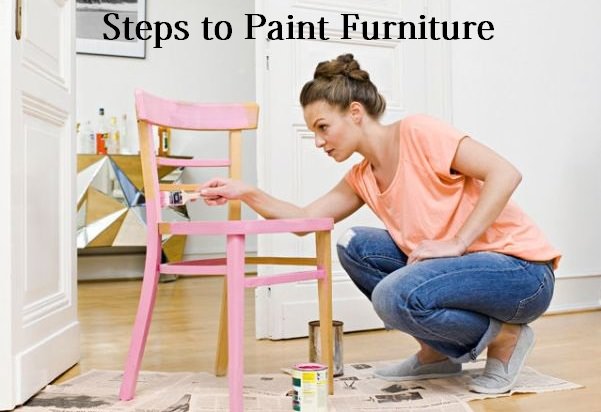Painting wooden furniture is a way to give a new life to an older chair or another type of wood piece. Painted accent piece can add charming touch to your home but also can less the charming if done incorrectly. The process of painting is relatively simple and require a few basic tools some time. This is not difficult but there are few consideration and steps involve which you need to follow. When painting a really nice piece, you need to paint, put as much effort in the prep and sanding stages as you do in the painting stages. The more time you will spend on prepping the piece furniture the less maintenance you will be doing on small chips of paint in the future. You need to follow these steps to paint furniture.

Steps to Paint Furniture:
1.) Prepare the Area to Paint Furniture
The first step is to prepare the area for the painting object. Place drop clothes on the floor where you are going to paint furniture. Open windows and doors to allow plenty of ventilation in the area because of paint release the bad fumes which are harmful to health. Then position the wood furniture that is to be painted on the clothes. You need to put the mask to get rid of bad fumes and possibly gloves in order to safe keep away from your hand otherwise it is hard to remove paint from the skin.
2.) Remove any Necessary Hardware from the Furniture
If you are renovating a chest of drawers, or a dresser or anything else, in that case, you will need to remove any hardware that is attached before you paint furniture.
- You need to ensure that the hardware is paint free when you reattach it and that the entire piece will be adequately covered with paint if you decide that you want to use a different hardware.
3.) Patch any Chipped, Holed or Pitted Surfaces with Wood Filler
Apply the wood filler to the damaged part of the wood, not to the undamaged wood. There can be some overlap which you can sand it down later. Use the putty knife to scrape away excess wood filler and let it dry.
- If you are going to replace any hardware on your furniture, then first fill the old holes where the previous hardware was attached. Then scrape flush to the board with a putty knife and let it dry.
4.) Remove loose Paint to Paint Furniture
You will need to scrape off the loose paint, being careful not to gouge the wood with the scraper by holding it parallel to the wood and applying even pressure.
5.) Sandpaper the Surface of the Furniture
You can use a piece of sandpaper with a sandpaper block, or by using a hand sander for the larger pieces. The goal is to remove any protective layer that is on the surface of the wood, which will make it easier for the prime coat to adhere.
- You will need to pay close attention to any scroll work or other ingredients in the wood, make sure to sand those by hands as thoroughly as possible.
- Or pay special attention to the areas where wood filler was applied. You will need to sand enough so that the filled portions are flush with the rest of the furniture.
- Then remove any residue left after sanding to the furniture surface. Wipe them gently with a clean tack cloth, it will help to remove the residue and leave the surface clean. If necessary so you can also use a mild detergent and wipe the wood surface dry with the cloth.
6.) Prime to Paint Furniture
Prime a furniture if you want an even look on your furniture. Use a roller and a paintbrush, and gently brush an even coat of the primer on the surface of the wood. You can use a paintbrush along corners edges and harder to reach areas. Use a roller for the wide space area, even areas that are not contoured. Allow the primer to dry before moving on to paint furniture piece.
- If you want your coat of paint to adhere evenly to the wood, and you want the paint to last long, you are going to want to add a primer before you plant. Don’t worry about getting even coverage with the primer, as long as it coats what you are going to paint you are good to go
- If you want more of weathered, distressed look on your furniture, you want to skip the primer. You need to know that the paint may eventually chip if no primer has been set down for painting.
- If you’re going for more of a weathered, distressed look on your furniture, you may want to skip the primer. Note that the paint may chip if no primer has been set down for painting.
- Primer often used for the surfaces for the extra thick for added coverage. If you are painting a tabletop or a desktop you may want to lather on a couple of layers or one thick layer. To give added protection and sheen to often used as a part of your furniture.
- Then go over the area of the primed surface with a fine grit sandpaper. This will help your paint bond to the primer even better than it already is. make sure to wipe away any sawdust or residue with a tack cloth before you hit the surface with the paint.
7.) Paint Furniture
Go over the surfaces of the furniture with a foam roller. If it is possible then using even strokes, redo the area with a paintbrush, you need to pay the attention to the places where the roller cannot reach. Such as edges and corner. Then let the coat dry and inspect the piece for any areas that are not completely covered by the paint.
- Consider using a paint conditioner to make your job easier. You can use a paint conditioner such as floral for latex paints and penetrol for oil paints, it will slow down the drying edge of the pant, and allow you to get a more even look on your paint. If the paint will dry too quickly, it will look patchy or uneven. Paint conditioner although added to your paint, will not change the color.
- Purchase a good quality paintbrush to do the job because poor quality brush will result in inferior looking projects. Bristles of the brush will come loose and get stuck in the paint, or the coverage just will not took uniform. If you will buy a good paintbrush, it will be slightly more expensive, but with proper care, it will last longer.
8.) Second Coat to Paint Furniture
Most painters believe that a coat of primer and paint only will not give the professional look that they are seeking. Wait for the first coat of paint to get dry, let it dry for an overnight of wait for at least 6 hours. Then hit it with another coat of the same paint.
9.) Clear Coat
A polyurethane clear coat gives an added layer of sheen and hardens and protect the paint. Match oil based top coats with oil paints and water based top coats with water based paint. Then hold the can 10 to 12 inches away and spray using a back and forth motion. You only need to follow the natural lines of the chair to coat it evenly.
10.) Let it Dry
Let your furniture cure in a warm, dry and well-ventilated area before use, typically for about 24 hours. Once you know how easy it is to repaint wooden furniture, you will see the hidden potential in all kinds of pieces.
Tips
- Depending on the size of the wooden furniture, you can use an acrylic spray paint to create the look you want. In that case, there is no need to apply a sealant after painting, as the acrylic will provide the adequate protection.
- You can minimize the number of coats need by using one trick. You need to pass some of the paint to the primer. This will make it possible to create a thicker barrier between the paint and the wood, and it will also minimize the chances of the wood grain bleeding through a single coat of paint.
- You can scrap paint to get a really nice rustic look.
You may also like to read How to Remove Wallpaper?















